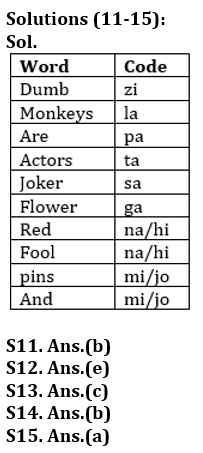Directions (1–5): In each of the question, relationships between some elements are shown in the statements(s). These statements are followed by conclusions numbered I and II. Read the statements and give the answer.
(a) If only conclusion I follows.
(b) If only conclusion II follows.
(c) If either conclusion I or II follows.
(d) If neither conclusion I nor II follows.
(e) If both conclusions I and II follow.
Q1. Statements: E ≤ R >T, G > R, K < R
Conclusions: I. K > T II. G > T
Q2. Statements: V >B >M > G > L < I ≤ J
Conclusions: I. V > J II. I ≥ B
Q3. Statements: O < M < Y > D, W<Y
Conclusions: I. Y> O II. W>O
Q4. Statements: I ≥ J> R > E < L, X < L, E > Y
Conclusions: I. I >E II. J>Y
Q5. Statements: P < W < Y ≥ I > V, Y > X
Conclusions: I. W < V II. Y> P
Directions (6-10): In these questions, relationship between different elements is shown in the statements. These statements are followed by two conclusions.
Mark answer as
Q6. Statement: Z≥O≥N=E>K, J>R=S≤N
Conclusion: I. N≥J II. J>E
(a) If only conclusion II follows.
(b) If only conclusion I follows.
(c) If both conclusion I and conclusion II follow
(d) If neither conclusion I nor conclusion II follows.
(e) If either conclusion I or conclusion II follows.
Q7. Statement: F≥R>I>E≤N, E=D≥T
Conclusion: I. F≥T II. R>T
(a) If neither conclusion I nor conclusion II follows.
(b) If only conclusion I follows.
(c) If both conclusion I and conclusion II follow
(d) If only conclusion II follows.
(e) If either conclusion I or conclusion II follows.
Q8. Statement: A<B≤C=D, E≥C≤F≤G
Conclusion: I. E>A II. G>A
(a) If only conclusion II follows.
(b) If either conclusion I or conclusion II follows.
(c) If both conclusion I and conclusion II follow
(d) If neither conclusion I nor conclusion II follows.
(e) If only conclusion I follows.
Q9. Statement: F≥R≤I>E≤N, E=D≥T
Conclusion: I. T>N II. N≥T
(a) If neither conclusion I nor conclusion II follows.
(b) If only conclusion I follows.
(c) If both conclusion I and conclusion II follow
(d) If only conclusion II follows.
(e) If either conclusion I or conclusion II follows.
Q10. Statement: A<B≤C=D, E≥C≤F≤G
Conclusion: I. G>A II. D>G
(a) If only conclusion I follows.
(b) If only conclusion II follows.
(c) If both conclusion I and conclusion II follow
(d) If neither conclusion I nor conclusion II follows.
(e) If either conclusion I or conclusion II follows.
Directions (11-15): Study the following information carefully to answer the given questions.
‘Dumb monkeys are actors’ is coded as ‘la pa zi ta’
‘Joker monkeys are dumb’ is coded as ‘pa zi la sa’
‘Flower are red fool’ is coded as ‘na hi ga pa’
‘Dumb pins and flower’ is coded as ‘zi mi jo ga’
Q11. How will ‘dumb joker flower’ be coded in the given language?
(a) zi la sa
(b) zi sa ga
(c) sa mi jo
(d) pa zi mi
(e) None of these
Q12. How will ‘flower are fool’ be coded in the given language?
(a) zi la sa
(b) zi sa ga
(c) sa mi jo
(d) pa zi mi
(e) None of these
Q13. What does ‘pa’ stands for?
(a) Joker
(b) Flower
(c) Are
(d) Pins
(e) None of the these
Q14. Which of the following will be coded as ‘na hi la’ in the given language?
(a) monkeys are fool
(b) red fool monkeys
(c) joker monkeys flower
(d) red dumb flower
(e) none of these
Q15. What is the code for ‘la’ stand for?
(a) Monkeys
(b) Flower
(c) Joker
(d) Fool
(e) none of these.
Solutions
Solutions (1-5):
S1. Ans. (b)
S2. Ans. (d)
S3. Ans. (a)
S4. Ans. (e)
S5. Ans. (b)
Solutions (6-10):
S6. Ans. (e)
S7. Ans. (d)
S8. Ans. (c)
S9. Ans. (d)
S10. Ans. (a)









 GA Capsule for SBI Clerk Mains 2025, Dow...
GA Capsule for SBI Clerk Mains 2025, Dow...
 The Hindu Review October 2022: Download ...
The Hindu Review October 2022: Download ...
 SBI PO Mains Preparation Strategy 2025, ...
SBI PO Mains Preparation Strategy 2025, ...





